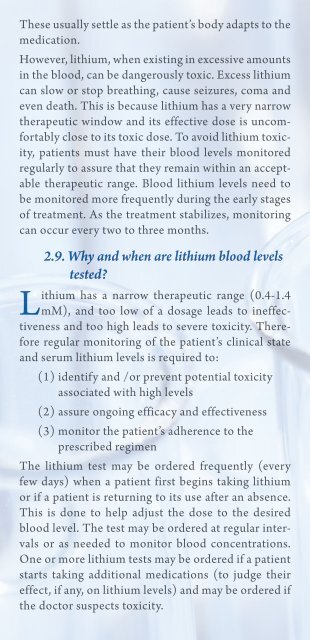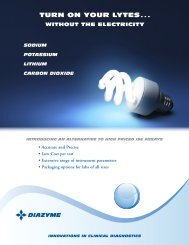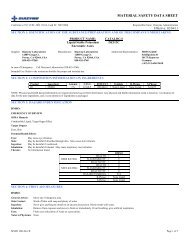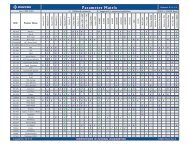Lithium test - Diazyme Laboratories
Lithium test - Diazyme Laboratories
Lithium test - Diazyme Laboratories
You also want an ePaper? Increase the reach of your titles
YUMPU automatically turns print PDFs into web optimized ePapers that Google loves.
These usually settle as the patient’s body adapts to the<br />
medication.<br />
However, lithium, when existing in excessive amounts<br />
in the blood, can be dangerously toxic. Excess lithium<br />
can slow or stop breathing, cause seizures, coma and<br />
even death. This is because lithium has a very narrow<br />
therapeutic window and its effective dose is uncomfortably<br />
close to its toxic dose. To avoid lithium toxicity,<br />
patients must have their blood levels monitored<br />
regularly to assure that they remain within an acceptable<br />
therapeutic range. Blood lithium levels need to<br />
be monitored more frequently during the early stages<br />
of treatment. As the treatment stabilizes, monitoring<br />
can occur every two to three months.<br />
2.9. Why and when are lithium blood levels<br />
<strong>test</strong>ed?<br />
<strong>Lithium</strong> has a narrow therapeutic range (0.4-1.4<br />
mM), and too low of a dosage leads to ineffectiveness<br />
and too high leads to severe toxicity. Therefore<br />
regular monitoring of the patient’s clinical state<br />
and serum lithium levels is required to:<br />
(1) identify and /or prevent potential toxicity<br />
associated with high levels<br />
(2) assure ongoing efficacy and effectiveness<br />
(3) monitor the patient’s adherence to the<br />
prescribed regimen<br />
The lithium <strong>test</strong> may be ordered frequently (every<br />
few days) when a patient first begins taking lithium<br />
or if a patient is returning to its use after an absence.<br />
This is done to help adjust the dose to the desired<br />
blood level. The <strong>test</strong> may be ordered at regular intervals<br />
or as needed to monitor blood concentrations.<br />
One or more lithium <strong>test</strong>s may be ordered if a patient<br />
starts taking additional medications (to judge their<br />
effect, if any, on lithium levels) and may be ordered if<br />
the doctor suspects toxicity.<br />
Once stable blood concentrations in the therapeutic<br />
range have been achieved, lithium may then be monitored<br />
at regular intervals to ensure that it remains in<br />
this range.<br />
The <strong>test</strong> may also be ordered when a patient’s condition<br />
does not appear to be responding to initial lithium<br />
dosage levels in order to determine whether concentrations<br />
are too low, the medication is ineffective,<br />
and/or to determine if the patient is complying with<br />
therapy (taking the lithium regularly). It may also be<br />
ordered when a patient experiences a troublesome<br />
level of side effects and/or exhibits symptoms that<br />
the doctor suspects may be due to toxicity.<br />
Patients should talk to their doctor about the timing<br />
of the sample collection. <strong>Lithium</strong> blood levels are<br />
generally performed 12-18 hours after the last dose.<br />
Since dosage timing varies and some formulations are<br />
time released, collection specifics may vary.<br />
3. Methods used for<br />
lithium <strong>test</strong>ing<br />
Methods used for lithium <strong>test</strong>ing in clinical laboratories<br />
are continuously evolving. Before 1987,<br />
lithium was measured by flame atomic emission spectrometry<br />
(FAES) in about 90% of laboratories and by<br />
flame atomic absorption spectrometry (FAAS) in the<br />
rest. In 1987, the first generation Ion-Selective Electrode<br />
(ISE) technique based lithium analyzer (NOVA<br />
Biomedical, Co. Waltham, MA) was introduced, and<br />
within 2 years, (by 1989), the ISE lithium <strong>test</strong> reached<br />
approximately 20% of the total clinical lithium <strong>test</strong>ing,<br />
owing to its cost advantages and ease of use in comparison<br />
to the FAES method. In 2001, a colorimetric<br />
assay was developed by Trace American Inc. (now<br />
Thermo Fisher) utilizing a reaction between lithium<br />
and a porphyrin dye. This dye based lithium assay immediately<br />
became popular in clinical laboratories as








